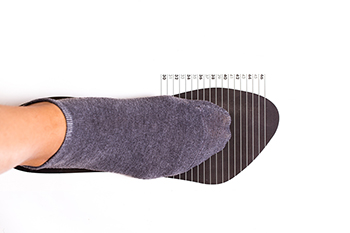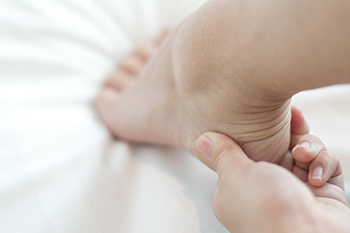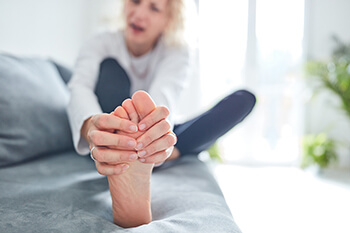Items filtered by date: March 2022
Finding Shoes That Fit
 In a world where shoe sizes aren't standardized internationally and many shoes on the market are made with only style in mind, it can be difficult to find shoes that fit properly. Your feet gradually swell throughout the day. This means that the best time to shop for shoes is in the evening, as that is when your feet are at their largest. If the shoes you buy fit comfortably when your feet are at their largest, then they will likely fit your feet comfortably throughout the entire day. On the same note, if your feet are two different sizes, you should buy shoes that comfortably fit the larger of your two feet. When trying on shoes, wear the socks that you would normally wear with that type of shoe. Leave a half-inch of space at the front of the shoe (between the end of your longest toe and the end of the front of the shoe) and an eighth inch of space at the back of the shoe (between the back of your heel and the shoe) for a comfortable fit. You should also make sure that the toe area of the shoes is not too tight or narrow. For more tips on finding the right size shoe for you, please consult with a chiropodist.
In a world where shoe sizes aren't standardized internationally and many shoes on the market are made with only style in mind, it can be difficult to find shoes that fit properly. Your feet gradually swell throughout the day. This means that the best time to shop for shoes is in the evening, as that is when your feet are at their largest. If the shoes you buy fit comfortably when your feet are at their largest, then they will likely fit your feet comfortably throughout the entire day. On the same note, if your feet are two different sizes, you should buy shoes that comfortably fit the larger of your two feet. When trying on shoes, wear the socks that you would normally wear with that type of shoe. Leave a half-inch of space at the front of the shoe (between the end of your longest toe and the end of the front of the shoe) and an eighth inch of space at the back of the shoe (between the back of your heel and the shoe) for a comfortable fit. You should also make sure that the toe area of the shoes is not too tight or narrow. For more tips on finding the right size shoe for you, please consult with a chiropodist.
Finding the right shoes can be a hassle, however, wearing properly fitted shoes is one of the best things that you can do to prevent future foot problems. For more information about the importance of wearing the right shoe size, please consult with one of the chiropodists from Complete Family Footcare & Therapy. Our clinicians can help you maintain the health of your lower limbs and your mobility.
Tips for finding shoes that fit
-
Measure your foot - This should be done later in the day when your feet are naturally at their largest. An associate at a shoe store can measure your foot using a Brannock device.
-
Wear the right socks - You should be wearing the socks or other hosiery that you intend to wear with the kind of shoe you are looking for. For example, if you are shopping for running shoes, wear the socks that you would normally wear while running.
-
Remember these numbers - When trying on shoes, there should be about ½ an inch of space between the end of your longest toe and the end of the front of the shoe, and ⅛ of an inch between the back of your heel and the shoe
-
Don’t “break them in” - Any shoes you buy should be immediately comfortable; don’t settle for shoes that you have to “break in" before you can wear them out.
A chiropodist can help you find the best shoes and orthotics to help maintain the health of your feet. If you have any questions, please feel free to contact our offices located in . We offer the newest diagnostic and treatment technologies for all your foot care needs.
Read more about Getting the Right Shoe SizeCommon Foot Problems During Pregnancy
 The major changes that occur during pregnancy can affect the entire body, including the feet and ankles. One of the most common pregnancy foot problems is foot swelling caused by fluid retention. Another is flat feet. During pregnancy, the ligaments throughout the body tend to relax, including those in the arch of the foot. This can cause the arch to flatten, increasing your shoe size and potentially leading to foot soreness, discomfort, or pain. To help ease this pain, make sure to wear comfortable shoes. It is also important to rest your feet when possible, and resting the feet above the hips can help with circulation. To learn more about common pregnancy foot problems and what you can do to alleviate them, please consult with a chiropodist.
The major changes that occur during pregnancy can affect the entire body, including the feet and ankles. One of the most common pregnancy foot problems is foot swelling caused by fluid retention. Another is flat feet. During pregnancy, the ligaments throughout the body tend to relax, including those in the arch of the foot. This can cause the arch to flatten, increasing your shoe size and potentially leading to foot soreness, discomfort, or pain. To help ease this pain, make sure to wear comfortable shoes. It is also important to rest your feet when possible, and resting the feet above the hips can help with circulation. To learn more about common pregnancy foot problems and what you can do to alleviate them, please consult with a chiropodist.
Pregnancy can affect your feet in many ways, often causing pain or discomfort, as well as reduced mobility. If you are pregnant and experience foot pain, please consult with one of the chiropodists from Complete Family Footcare & Therapy. Our clinicians will assess your condition and provide you with quality foot and ankle treatment.
During pregnancy, your belly isn’t the only part of your body swelling. The whole body may experience swelling, especially in the feet and ankles. Since they carry the weight of both your body and the baby’s, caring for your feet during pregnancy is very important.
Common Foot Conditions During Pregnancy
Various foot conditions can develop during the course of a pregnancy, including:
-
Swelling of the feet and ankles
-
Fallen arches, leading to acquired flat feet
-
Plantar fasciitis
-
Aching, sore feet
-
Changes in the toenails
Caring for the Feet During Pregnancy
Some things that you can do to help maintain the health of your feet during pregnancy include:
-
Wearing comfortable shoes
-
Resting and elevating your feet
-
Icing sore areas, such as the arch
-
Keeping your toenails trimmed
-
Soaking and massaging the feet
If you have any questions, please feel free to contact our offices located in . We offer the newest diagnostic and treatment technologies for all your foot care needs.
Read more about Pregnancy and Foot HealthSigns and Causes of Poor Circulation
 Poor circulation in the lower limbs can be a serious cause for concern. When blood flow to the feet and ankles is reduced, the oxygen and nutrients that keep the lower limbs healthy can’t get to where they need to go. This can cause symptoms such as coldness, numbness, discoloration, and pain in the feet and ankles. The skin may become cracked and dry, and wounds that heal slowly and poorly are more likely to form on the feet. Poor circulation is almost always caused by an underlying health condition, such as diabetes or peripheral artery disease. Your chiropodist can perform quick and non-invasive screenings to determine if you have poor circulation. For more information about keeping your feet and ankles healthy, please consult with a chiropodist.
Poor circulation in the lower limbs can be a serious cause for concern. When blood flow to the feet and ankles is reduced, the oxygen and nutrients that keep the lower limbs healthy can’t get to where they need to go. This can cause symptoms such as coldness, numbness, discoloration, and pain in the feet and ankles. The skin may become cracked and dry, and wounds that heal slowly and poorly are more likely to form on the feet. Poor circulation is almost always caused by an underlying health condition, such as diabetes or peripheral artery disease. Your chiropodist can perform quick and non-invasive screenings to determine if you have poor circulation. For more information about keeping your feet and ankles healthy, please consult with a chiropodist.
When blood flow to a specific part of the body is reduced, you may experience symptoms of poor circulation. Poor circulation is most common in your extremities, like your legs and feet. Please consult with one of the chiropodists from Complete Family Footcare & Therapy. Our clinicians will assess your condition and provide you with quality foot and ankle treatment.
Causes
Poor circulation isn’t a condition in itself. Instead, it results from other health issues. Therefore, it’s important to treat the underlying causes:
-
Peripheral artery disease (PAD)
-
Diabetes
-
Blood clots
-
Varicose veins
-
Obesity
-
Raynaud’s disease
Symptoms
Symptoms of poor circulation may include:
-
Numbness
-
Tingling
-
Throbbing or stinging pain in limbs
-
Pain
-
Muscle Cramps
Diagnosis
A chiropodist will perform a physical exam to detect pain and swelling, as well as an antibodies blood test to detect inflammatory conditions, such as Raynaud’s disease. It’s important to disclose any known family history of poor circulation and any related diseases. A blood sugar test, blood pressure test, ultrasound, or CT scan may also be performed.
Treatment
Treatments for poor circulation depend on what is causing it. Compression socks may be used to reduce pain and swelling. An exercise program may be recommended to improve circulation. Various medications may be prescribed to manage underlying conditions that may contribute to poor circulation.
If you have any questions, please feel free to contact our offices located in . We offer the newest diagnostic and treatment technologies for all your foot care needs.
Read more about Poor CirculationAre Bunions Affecting Your Everyday Life?
What Is Sever’s Disease?
 Sever’s disease, also known as calcaneal apophysitis, refers to an inflammation of the growth plate in the heel. It is one of the most common foot injuries in children and adolescents between the ages of 8 and 14. It is especially common in children who are involved in sports activities such as soccer, running, or basketball. Symptoms of Sever’s disease include pain in the back or bottom of the heel, pain when the sides of the heel are squeezed, difficulty running, jumping, or walking, limping, walking on the toes to avoid putting pressure on the heels, and tiredness. There are various treatments for Sever’s disease including resting the foot by stopping or reducing participation in the activity that caused it, supporting the heel with shoe inserts or custom orthotics, and taking oral medications to reduce pain and inflammation. If your child complains of heel pain, it is highly recommended that you take them to see a chiropodist.
Sever’s disease, also known as calcaneal apophysitis, refers to an inflammation of the growth plate in the heel. It is one of the most common foot injuries in children and adolescents between the ages of 8 and 14. It is especially common in children who are involved in sports activities such as soccer, running, or basketball. Symptoms of Sever’s disease include pain in the back or bottom of the heel, pain when the sides of the heel are squeezed, difficulty running, jumping, or walking, limping, walking on the toes to avoid putting pressure on the heels, and tiredness. There are various treatments for Sever’s disease including resting the foot by stopping or reducing participation in the activity that caused it, supporting the heel with shoe inserts or custom orthotics, and taking oral medications to reduce pain and inflammation. If your child complains of heel pain, it is highly recommended that you take them to see a chiropodist.
Sever’s disease typically affects young children and teenagers. If your child complains of foot pain, please consult with one of the chiropodists from Complete Family Footcare & Therapy. Our clinicians will assess your condition and provide you with quality foot and ankle treatment.
What Is Sever’s Disease?
Sever’s disease, also known as calcaneal apophysitis, is an inflammation of the growth plate in the heel bone. It is typically caused by overuse due to repetitive activities such as running, jumping, and playing certain sports. This condition most frequently affects children between the ages of 8 and 14.
Symptoms
Symptoms of Sever’s disease include:
-
Pain in the back or bottom of the heel
-
Pain when the sides of the heel are squeezed
-
Limping or walking on tiptoes to avoid putting pressure on the heel
-
Difficulty running, jumping, or participating in usual activities
-
Fatigue
Diagnosis
Sever’s disease is diagnosed by taking a thorough medical history and performing a physical examination. Imaging studies, such as an X-ray, can help rule out other injuries like a fracture.
Treatment
Sever’s disease typically heals without any long-term complications. Treatment involves resting the affected foot by reducing typical activities, wearing orthotics to support the foot, immobilizing the affected foot, taking medications to reduce pain and inflammation, and stretching the foot.
If you have any questions, please feel free to contact our offices located in . We offer the newest diagnostic and treatment technologies for all your foot care needs.
Read more about Sever's DiseaseWhy Does My Foot Hurt?
 Foot pain is a common symptom for a variety of different foot conditions. The location of pain within the foot may help determine what the cause is. Heel pain is often associated with plantar fasciitis, an inflammation in the band of tissue that runs along the bottom of the foot connecting the heel bone to the toes. Stone bruises are deep bruises on the fat pad of the heel, and heel spurs are irregular bone growths on the bottom of the heel. Both conditions are also causes of foot and heel pain. Pain in the ball of the foot can be caused by conditions like metatarsalgia, Morton’s neuroma, and sesamoiditis. Pain in the arch of the foot may be caused by flat feet, but more commonly, arch pain is caused due to plantar fasciitis. Toe pain can be caused by gout, arthritis, foot deformities like hammertoes or bunions, ingrown toenails, or injuries to the toe such as a strain, sprain, or fracture. To determine the cause of your foot pain and to find the best treatment, consult with a chiropodist today.
Foot pain is a common symptom for a variety of different foot conditions. The location of pain within the foot may help determine what the cause is. Heel pain is often associated with plantar fasciitis, an inflammation in the band of tissue that runs along the bottom of the foot connecting the heel bone to the toes. Stone bruises are deep bruises on the fat pad of the heel, and heel spurs are irregular bone growths on the bottom of the heel. Both conditions are also causes of foot and heel pain. Pain in the ball of the foot can be caused by conditions like metatarsalgia, Morton’s neuroma, and sesamoiditis. Pain in the arch of the foot may be caused by flat feet, but more commonly, arch pain is caused due to plantar fasciitis. Toe pain can be caused by gout, arthritis, foot deformities like hammertoes or bunions, ingrown toenails, or injuries to the toe such as a strain, sprain, or fracture. To determine the cause of your foot pain and to find the best treatment, consult with a chiropodist today.
Foot pain can have many causes. To receive an accurate diagnosis and treatment for your foot pain, please consult with one of the chiropodists from Complete Family Footcare & Therapy. Our clinicians will assess your condition and provide you with quality foot and ankle treatment.
Causes
There are a variety of different conditions that can cause foot pain, including:
-
Plantar fasciitis
-
Deformities, such as bunions or hammertoes
-
Injuries to the muscles, bones, tendons, or ligaments in the feet
-
Arthritis
-
Flat feet
-
Ingrown toenails
Symptoms
The type and location of your foot pain can help determine what may be causing it and what type of treatment options are best for you.
Common types of foot pain include:
-
Heel pain
-
Arch pain
-
Toe pain
-
Ball of foot pain
-
Pain that has a stabbing, burning, or tingling quality
-
Pain that is constant, intermittent, or that gets better or worse depending on the situation
Diagnosis
A thorough medical history and physical examination of your feet will be required to determine a diagnosis. Imaging studies, such as X-rays or MRIs may be performed to rule out or confirm certain diagnoses.
Treatment
Treatment will depend on the cause of the pain. Common treatments for foot pain include resting, icing, compressing, and elevating the affected foot, wearing orthotics, or taking anti-inflammatory medications.
If you have any questions, please feel free to contact our offices located in . We offer the newest diagnostic and treatment technologies for all your foot care needs.
Read more about Foot Pain
